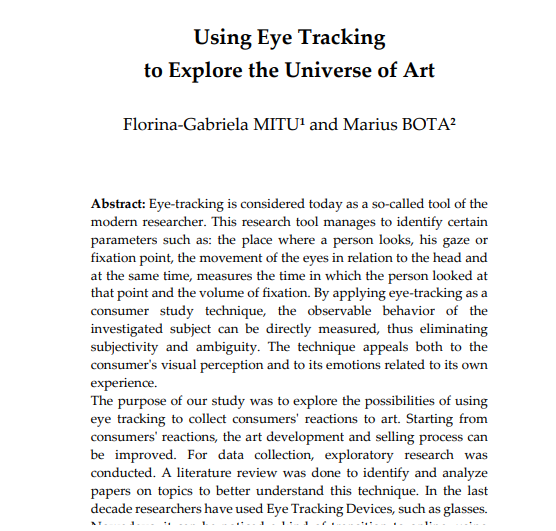Eye‐tracking is considered today as a so‐called tool of the modern researcher. This research tool manages to identify certain parameters such as: the place where a person looks, his gaze or fixation point, the movement of the eyes in relation to the head and at the same time, measures the time in which the person looked at that point and the volume of fixation. By applying eye‐tracking as a consumer study technique, the observable behavior of the investigated subject can be directly measured, thus eliminating subjectivity and ambiguity. The technique appeals both to the consumerʹs visual perception and to its emotions related to its own experience. The purpose of our study was to explore the possibilities of using eye tracking to collect consumersʹ reactions to art. Starting from consumersʹ reactions, the art development and selling process can be improved. For data collection, exploratory research was conducted. A literature review was done to identify and analyze papers on topics to better understand this technique. In the last decade researchers have used Eye Tracking Devices, such as glasses. Nowadays, it can be noticed a kind of transition to online, using screen‐based eye tracker. Are consumers all the same? What type of observer is more interesting to watch a visualreference, the typical one orthe one that is looking outside the battlefield? Based on these questions, most arts studies have shown that by using eye‐tracking technology to study the eye movement of art lovers while viewing paintings displayed on a computer screen in the laboratory, the subjects of the experiment have a completely distinct experience in terms of visualizing art and compared to the physical experience in an art museum.
Using Eye Trackingto Explore the Universe of Art
How to Use Eye Tracking to Explore the Universe of Art
We are thrilled to introduce you to a fascinating book that shows how eye tracking can reveal the secrets of art perception and appreciation.
What is Eye Tracking?
Eye tracking is a technology that measures where, when, and how long people look at different parts of a visual stimulus, such as a website, an advertisement, or a product. By analyzing eye movements, you can gain insights into the cognitive and emotional processes of your customers, such as what attracts their attention, what interests them, what confuses them, and what influences their decision making.
Why Eye Tracking and Art?
Art is one of the most complex and captivating forms of human expression. It can evoke a wide range of emotions, thoughts, and reactions in the observer. But how do we actually perceive and appreciate art? What makes us like or dislike a certain artwork? How do we interpret the meaning and message of an artist? These are some of the questions that eye tracking can help us answer.
What is the Book About?
The book “Using Eye Tracking to Explore the Universe of Art” is a comprehensive and accessible guide that explores how eye tracking can be used to study various aspects of art perception and appreciation. The book is written by a team of experts from different disciplines, such as art history, psychology, neuroscience, and computer science. They present a multidisciplinary approach that combines eye tracking technology with theoretical and empirical knowledge from art and cognitive sciences.
What Can You Learn from the Book?
The book is divided into three parts, each focusing on a different aspect of eye tracking research in art. The first part introduces the basic concepts and methods of eye tracking, as well as the main challenges and opportunities for applying this technique to art studies. The second part presents a series of case studies that illustrate how eye tracking can be used to address various research questions, such as how color, dynamism, content, and task affect visual behavior, how experts and novices differ in their gaze patterns, how eye movements relate to emotional responses and aesthetic judgments, and how eye tracking can be combined with other methods such as electroencephalography (EEG) and functional magnetic resonance imaging (fMRI) to measure brain activity. The third part explores the pedagogical implications and applications of eye tracking, such as how eye tracking can help students improve their visual literacy and analytical skills, how eye tracking can provide feedback and scaffolding to teachers and learners, and how eye tracking can be used to create interactive and adaptive learning environments.
Conclusion: A New Perspective on Art
By understanding the ‘where’ and ‘how’ of our visual journey through art, eye tracking empowers us to enrich the art experience. It’s an exciting time for artists, educators, and enthusiasts alike, as we continue to discover the profound impact of where our eyes lead us.
